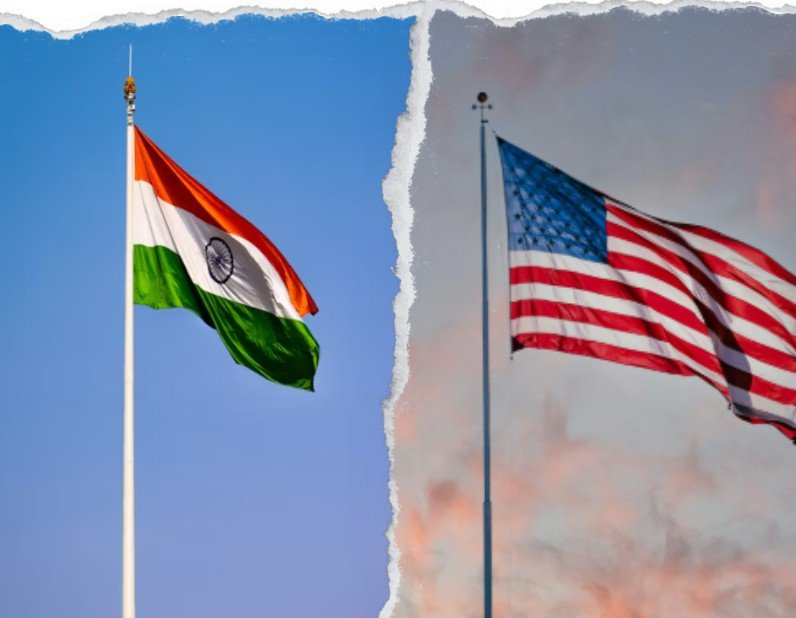By Arvind Sharma
In a dramatic escalation of trade tensions, US President Donald Trump on Wednesday announced a doubling of tariffs on Indian goods to 50%, significantly raising the stakes just weeks before a high-level American trade delegation is scheduled to visit New Delhi. The move, however, includes a 21-day grace period before the additional 25% tariffs take effect—offering India a critical window to negotiate a trade deal and avert further economic disruption.
This latest order brings US tariffs on India to their highest levels globally and signals an intensifying economic standoff between the two countries. It follows President Trump’s earlier announcement of a 25% tariff on Indian exports, originally set to take effect on August 1 but deferred to August 7 amid intense diplomatic back-channel talks.
The White House has framed the tariff hike as a response to what it calls India’s “excessive import duties and non-monetary trade barriers.” However, the move has further strained relations between the world’s largest democracies, especially in light of Washington’s displeasure over India’s continued purchases of Russian crude oil and defense equipment—a stance New Delhi defends as essential to its national interest and energy security.
Economic and Political Fallout
Economists warn the new tariffs could shave off up to 0.5% of India’s GDP, hitting key sectors such as pharmaceuticals, auto components, marine products, electronics, textiles, and apparel. The textile and apparel industry—heavily dependent on global pricing and US market access—is seen as particularly vulnerable.
Nonetheless, some industry analysts see a silver lining. The current crisis, they argue, may serve as a wake-up call for India to diversify its export portfolio and invest in high-potential sectors such as specialty chemicals, advanced ceramics, and high-end fashion textiles.
At the heart of the conflict lies India’s assertion of strategic autonomy. While the US is aggressively attempting to diplomatically and economically isolate Russia over the war in Ukraine, India has maintained a steady flow of imports from Moscow, citing its sovereign right to secure affordable energy and defense resources.
This independent stance has drawn criticism in Washington. Analysts believe the new tariffs are not just economic tools but also instruments of geopolitical pressure, designed to realign India’s foreign policy through economic coercion—a strategy that has raised concerns about the erosion of sovereignty in an increasingly polarized world order.
Diplomatic Channels Still Open
Despite the tensions, diplomatic engagement remains active. A senior-level US trade delegation is expected in New Delhi on August 25, with both countries aiming to finalize a bilateral trade agreement by September or October.
A senior official from India’s Commerce Ministry confirmed that retaliatory tariffs on selected US imports are under serious consideration. “India remains committed to a fair and balanced trade relationship,” the official stated. “But we will not hesitate to protect our economic sovereignty if required.” India is also weighing the option of approaching the World Trade Organization (WTO) should bilateral talks fail.
Political Repercussions at Home
The tariff announcement has sparked political debate within India. The opposition Congress Party accused the Modi government of “misplaced personal diplomacy” with President Trump and of failing to anticipate the long-term strategic risks involved.
Observers note that this is not an isolated development, but part of a broader trend in US trade policy under the Trump administration. Since early 2025, Washington has introduced or threatened punitive tariffs against several countries. A 26% tariff targeting Indian exports was floated in April but was shelved following diplomatic outreach. The newly announced 25% hike is widely viewed as a rebranded version of that earlier measure.
Some trade experts caution that these tariffs may become a semi-permanent fixture in the Indo-US trade landscape, compelling Indian exporters to recalibrate their strategies, explore alternative markets, or adjust pricing structures. Still, given the deep economic interdependence between the two nations, many remain hopeful that cooler heads will prevail.
Charges of Hypocrisy and Double Standards
Indian officials have raised questions about the consistency of the US’s trade policies. In response to President Trump’s claim that he was unaware of America’s own imports from Russia, Indian authorities pointed out that the US continues to buy uranium, palladium, fertilizers, and industrial chemicals from Moscow.
A spokesperson for India’s Ministry of External Affairs commented, “It is inappropriate and hypocritical to single out India. The United States itself continues energy and industrial trade with Russia.”
Adding to the chorus of concern, Indian-American Republican leader Nikki Haley posted on social media platform X (formerly Twitter):
“India shouldn’t be buying oil from Russia. But China—an adversary and the top buyer of Russian and Iranian oil—has been given a 90-day tariff waiver. Don’t punish allies like India. Don’t reward China.”
A Test of Diplomacy and Leadership
As global geopolitics enter an era of economic nationalism, the weeks ahead will be critical. Whether strategic diplomacy can overcome short-term economic aggression remains to be seen.
The Indian government, led by Prime Minister Narendra Modi, has successfully navigated complex international challenges in the past. With a seasoned diplomatic corps and strong economic fundamentals, there is cautious optimism that India can steer through this storm and arrive at a resolution that protects its national interests without derailing its partnership with the United States.
